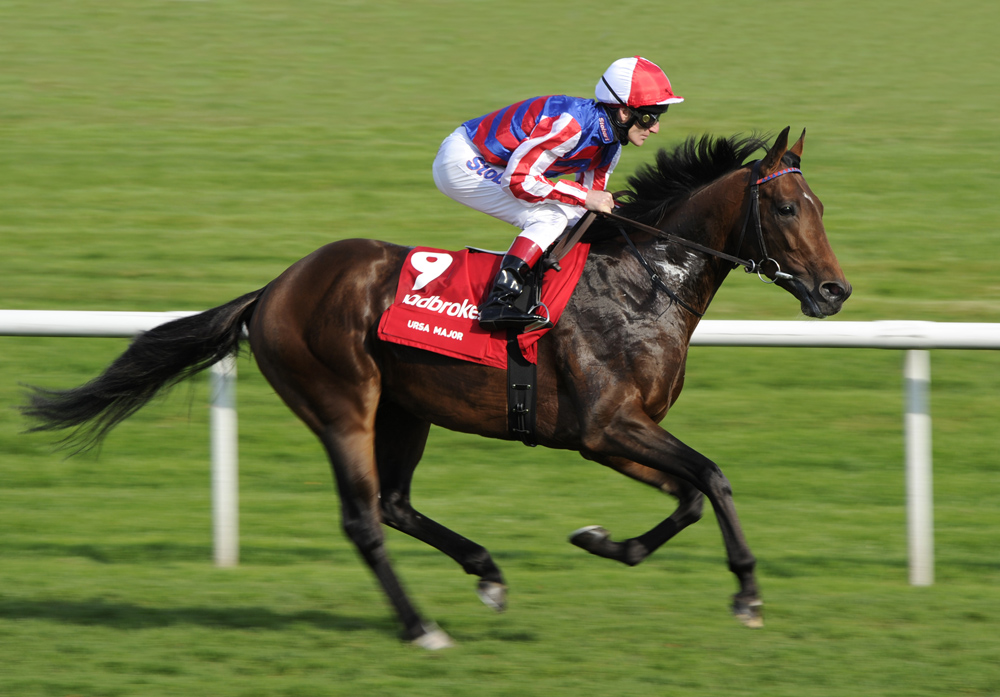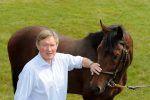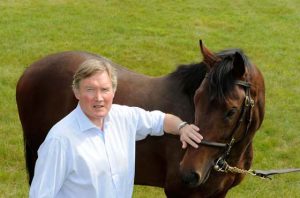It was abundantly clear that Andrew Tinkler enjoyed his entrée into racing. At the height of his expansion in 2010 he would stand by the rope at Tattersalls, visible to all, bidding away with a beaming smile on his face.
On he went: 100,000, 200,000, 300,000 guineas and beyond. On occasions, well beyond. The man who made his fortune through the Stobart Group haulage company was plainly in his element.
But things have changed. Tinkler’s craving for bidding duels has since succumbed to a desire to breed his own. So much so that the recent Tattersalls breeze-up sales, a previously fertile source, did not tempt him.
He now boards 16 broodmares in Newmarket at the Brook Stud, part-owned by his bloodstock advisor Dwayne Woods. Although he is still interested in the right yearling, it must now have paddocks appeal further down the line.
But that’s not all. The most striking difference between Tinkler old and new is the way he disperses his horses in training. This time two years ago he was keenly anticipating the exploits of around 20 horses he’d sent to be trained in Newmarket.
The twin knights, Cecil and Stoute, were recruited alongside William Haggas and Marco Botti. They complemented existing northern trainers Michael Dods and Bryan Smart, while out west Richard Hannon was sent a dozen juveniles.
I have always thought outside the box – I’ll go round corners to see if I can do things differently
Of the nine trainers he employed in 2011, Hannon fared best by far when Dubawi Gold and Tell Dad earned the thick end of £500,000 in Britain. Hannon was duly rewarded when Tinkler’s numbers swelled to 35 in 2012.
Hannon vindicated that faith with solid returns last year but, simultaneously, something was stirring in Ireland. Entries on behalf of Tinkler were made at Dundalk in February, when it emerged the owner had sent horses to Johnny Murtagh’s stable that housed Tommy Carmody, the former jumps jockey, as resident trainer.
“It started with Johnny [Murtagh] a few years ago when I was looking to retain a rider in the UK,” Tinkler, 49, reflects. “I ended up sponsoring him. Then I sent him some horses in the winter [of 2011] and we decided to run some of them in Ireland to see if it would work. Now it has developed further.”
So much so that the Murtagh/Carmody axis started 2013 with the bulk of Tinkler’s horses. There are ten juveniles within the team of 37. The only other trainer to be sent two-year-olds was Hannon, and of the quartet earmarked, three are now with Hannon’s former assistant Sylvester Kirk, also the trainer’s son-in-law.
“Richard [Hannon] deserves good horses and that’s the plan,” Tinkler says. “There’s no point keeping all-weather handicappers with him, which is why Sylvester came on board. Just like horses-for-courses, I believe in horses-for-trainers.”
There must be more to it, because the two-year-old with Hannon is now the sole horse Tinkler has with the two-time champion trainer. All the others have been moved.
There has certainly been no fall-out, as was evidenced when Tinkler hosted Hannon and his family in his box on 2,000 Guineas day. It’s more that the association with Murtagh has become all-embracing.
Well though Hannon did with Tinkler’s horses last season, he couldn’t match the Irish St Leger victory of Royal Diamond on the day when Ursa Major, another Tinkler horse trained at Murtagh’s yard, finished fourth in the British equivalent.
Indeed, Ursa Major was the animal responsible for Murtagh losing his retainer with the Aga Khan. The jockey couldn’t ride Hartani through injury when that colt succumbed to Ursa Major at the Curragh in August. Yet Murtagh compounded a delicate situation when he celebrated with the winner, rather than commiserating with connections of the Aga Khan-owned runner-up.
Murtagh’s fate doubtless encouraged him to look ahead. He has already completed the first course obligatory to all prospective trainers.
“I am certainly expecting Johnny to train one day,” Tinkler says.
However, Tinkler’s assertion that Hannon will train his better horses doesn’t tally with the transfer of Fort Knox, a promising maiden winner last season on his second start, to Murtagh’s stable over the winter.
“You need quality when you are trying to set something up,” Tinkler counters. “We had to move a number of horses to Ireland to make it work. We’re trying to make Johnny successful because that will make us successful.
“I think Richard understands what we’re trying to do. I am quite happy to move horses around when they are in training. That’s just business to me.”
Fort Knox, ridden by Murtagh, opened his account for his new stable with a convincing victory in April. So much so that he caught Sheikh Mohammed’s eye. A sale was agreed whereby Carmody would saddle Fort Knox for the Irish 2,000 Guineas ahead of a possible change of stable.
Fort Knox’s sale highlights another facet of Tinkler’s approach. Although he loves racing he is adamant it has to pay its way.
“I’ve always said in the past I’m trying to make it work commercially,” he says. “It’s a long-term aim. It won’t happen overnight, but businesses aren’t built overnight. We will also need a bit of luck because we are dealing with live animals.
“The way I look at it, prize-money has to pay the training fees and the rest is down to increasing the value of the horses. I have already sold some decent horses and I will continue to sell yearlings from my mares, provided I get what I think they are worth.
“Value-wise, if you have a horse rated over 80 you have jumped a barrier. And I’ve also learnt it is very important not to make too many mistakes by running them in the wrong place, or the wrong race. That’s a very quick way to erode value.”

Ursa Major in the hands of Johnny Murtagh, who is now training as well as riding
He is proud to have brought along a horse wanted by Sheikh Mohammed; doubly so in Fort Knox’s case, since he bought the colt as a foal. He also bought his dam Savannah Belle just before Fort Knox’s older full-brother, Dubawi Gold, chased Frankel home in the 2,000 Guineas two years ago.
Tinkler offered Fort Knox as a yearling but took him home when bidding stalled at 190,000gns. Compensation arrived 12 months later, when a yearling full-brother was sold to John Ferguson for 340,000gns.
Tinkler’s purchase of Savannah Belle has paid off handsomely, which may explain his orientation towards breeding his own stock. “Just as the deal over Fort Knox was being done, Savannah Belle popped out a really nice colt foal,” he says.
He believes the route to profitability lies in a collection of superior mares, adding: “Once you have the mares, the foals are born from a much lower cost base. That’s when I feel I’ll be able to get maximum value out of it. And if the progeny don’t make what you believe they are worth, you can improve the value by racing them. I like having options.”
Although there is nothing unusual in Tinkler’s approach per se, he has reached it by a circuitous route. That mirrors how he came to head up Stobart Group, the company from which he made in excess of £60 million when he took it onto the stock market in 2007.
He still owns a near-10% stake and remains the company’s Chief Executive despite some investor unrest. Together with fellow directors of the company he reversed a recent restructuring at Stobart just two months after it was implemented with a mandate to change direction – the group is involved in far more than haulage – with which Tinkler did not agree.
Despite his unconventional thinking he usually manages to persuade doubters to adopt his philosophy. In the pre-stock market listing he came up with all the ideas and his partner implemented them.
“I have always thought outside the box,” he says. “That’s how I have made my way in life: I’ll go round corners to see if I can do something differently. My way might be a slightly different approach to what you usually see in racing, but that’s because I am different. It hasn’t done me badly.”
As much as racing itself, Tinkler has been stimulated by discovering the complexities surrounding what appears on the surface to be a straightforward sport. His natural inquisitiveness is such that it fast-tracked him into the heart of it.
He has learnt much along the way and does not dwell on mistakes, preferring instead to log them under the “experience” column. Having coursed the sales for a few years he now has a different take on what he sees.
“The biggest lesson I have learnt is not to overpay for your horses in the first place,” he says. “You look at yearlings and they have great pedigrees, so they tempt you, but there is so much about them as individuals that you just don’t know. Very few of them turn out to be superstars.
“You learn something from every horse. A good-looking yearling could become a physical horror by the time it is three. It can fall away dramatically, so when you see a great-looking foal or yearling you are probably seeing it at its absolute best.
“At first I wanted those types of horses but now I prefer looking at yearlings where you can see improvement further down the line. And you’ve got to be prepared to forgive some physical faults as well, because the value is with horses in which something isn’t quite right.”
One striking thing about Tinkler is that he will always put his own philosophy into practice. The business of racing is conservative to the point where tangible progress is made only when someone approaches it with a fresh eye – and Tinkler’s is certainly that.
Time will tell whether his vision for a self-financing bloodstock model is realised. He does not subscribe to the racing maxim that the only way to end up with a small fortune is to start with a large one. Above all, however, he will do it his way.



